Trust is a collective project for the research, development and maintenance of shared infrastructure and imaginaries (Lore, cosmologies, myths and utopian conspiracy). Trust maintains a physical space in Berlin (shared with the Cybernetics Library) and an online network of collaborators around the world.


As part of Trust's collective reading series I co-hosted a discussion panel on community, world-building, and fandom and how we can use fan communities as a guide to imagine better communities and worlds in "real life" on May 18, 2021. A recording of the session is available, please contact me or Trust’s email for details.
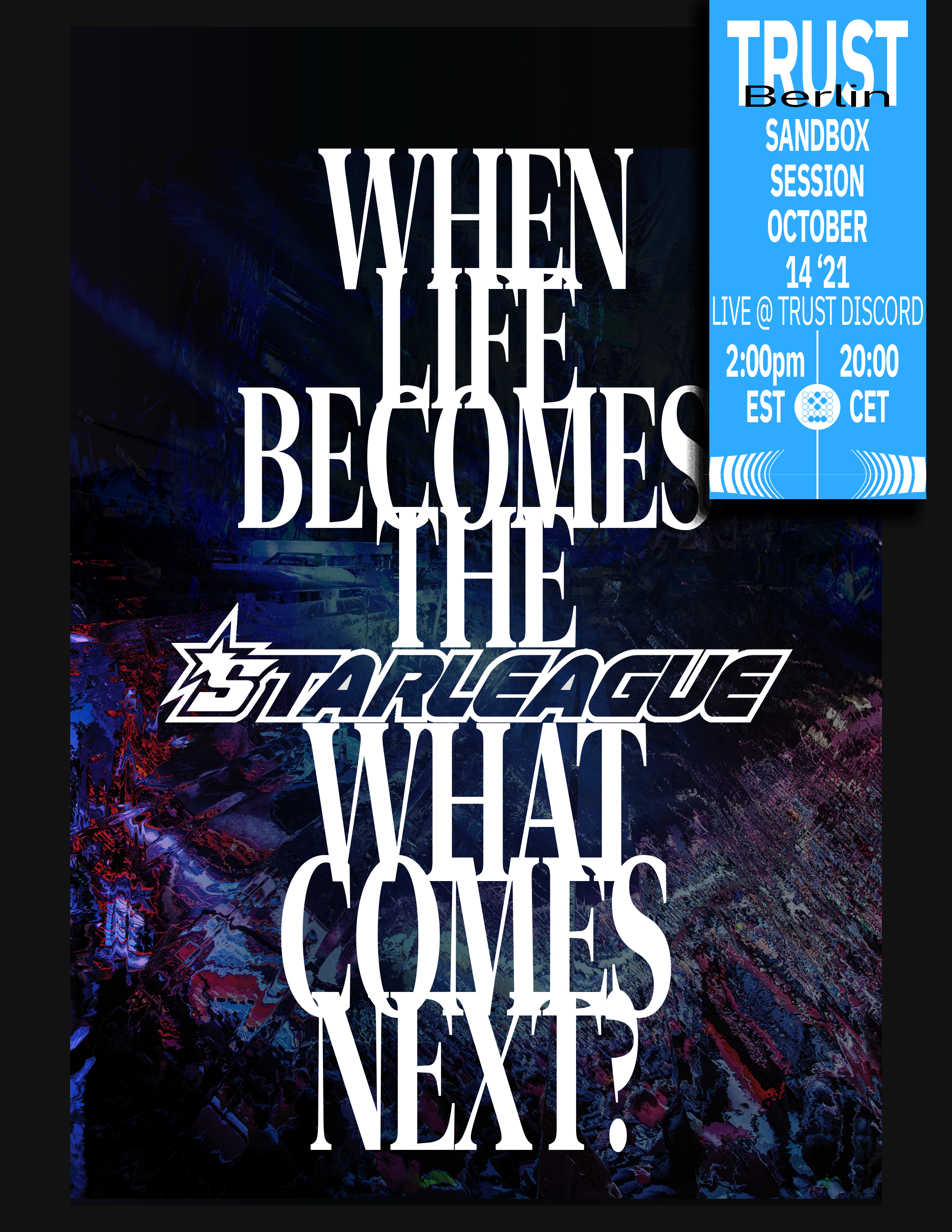
On October 14th 2021 I presented a talk in the Trust Discord space, “Until Everything Is A Starleague”, discussing the gamification of everyday life, esports, competittive gaming, celebrity, and lifestyle luxury brands. A recording of the session is available, please contact me or Trust’s email for details.
cover artwork, print design, layout, lettering, photography.
Halcyon Palace is an internet community of creatives, technologists, artists, skateboarders, fashion designers, writers, musicians, and many more to list, banded together under the shared dream of a kinder, cooler, more united internet. In addition to community events, concerts, competitions and limited-edition runs of wearables and collectables, Halcyon prides itself on its radical commitment to building a shared support network with mutual aid.
This is the third edition of the community zine, created by volunteers around the world and published in both English and Español, in print in a limited run and online, for free, forever.
In addition to design, I contributed the introductory piece and the essay “Beneath the Leviathans, There Is Room In The Forests”, a meditation on community and identity in the rapidly changing internet.
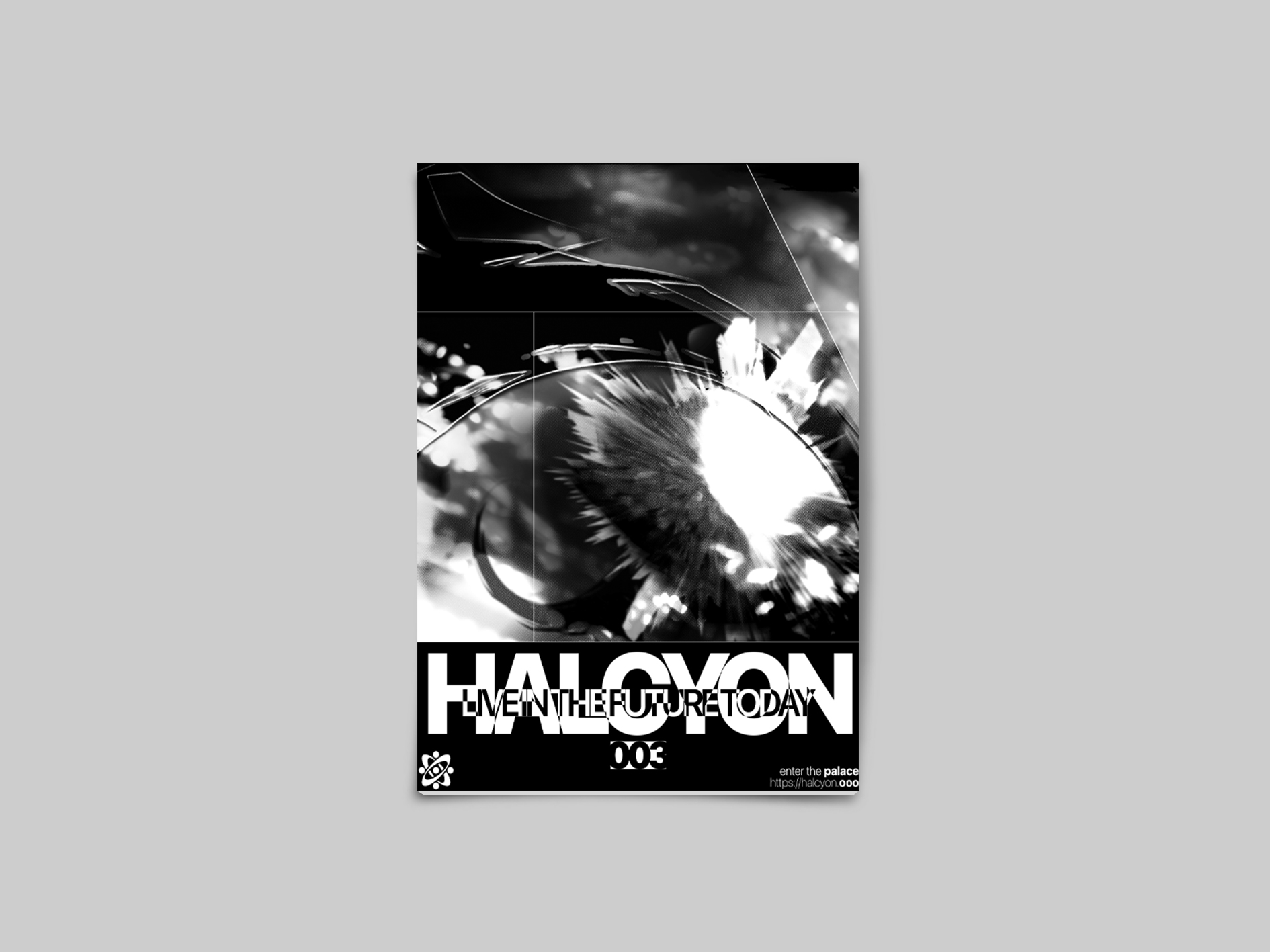




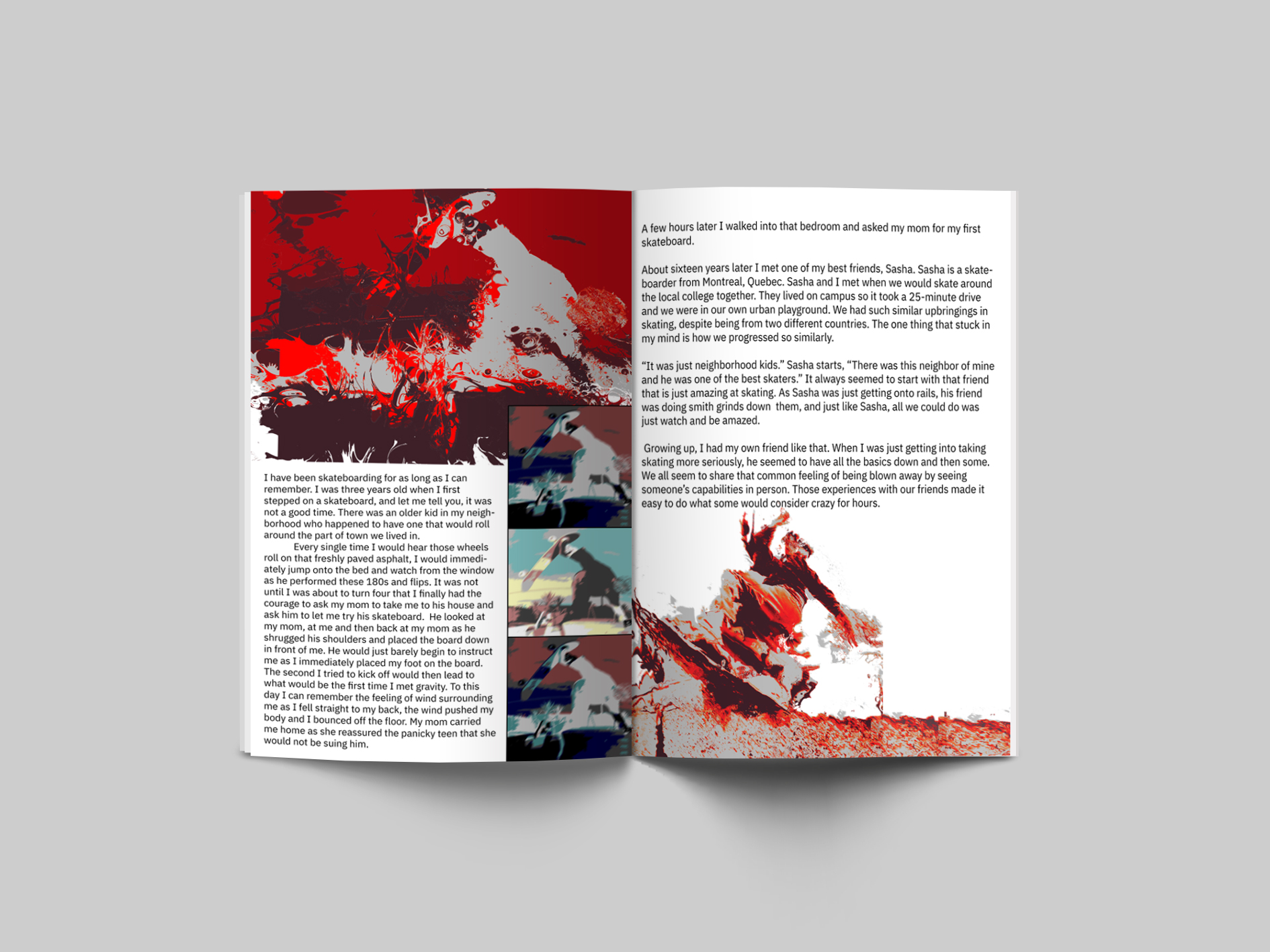
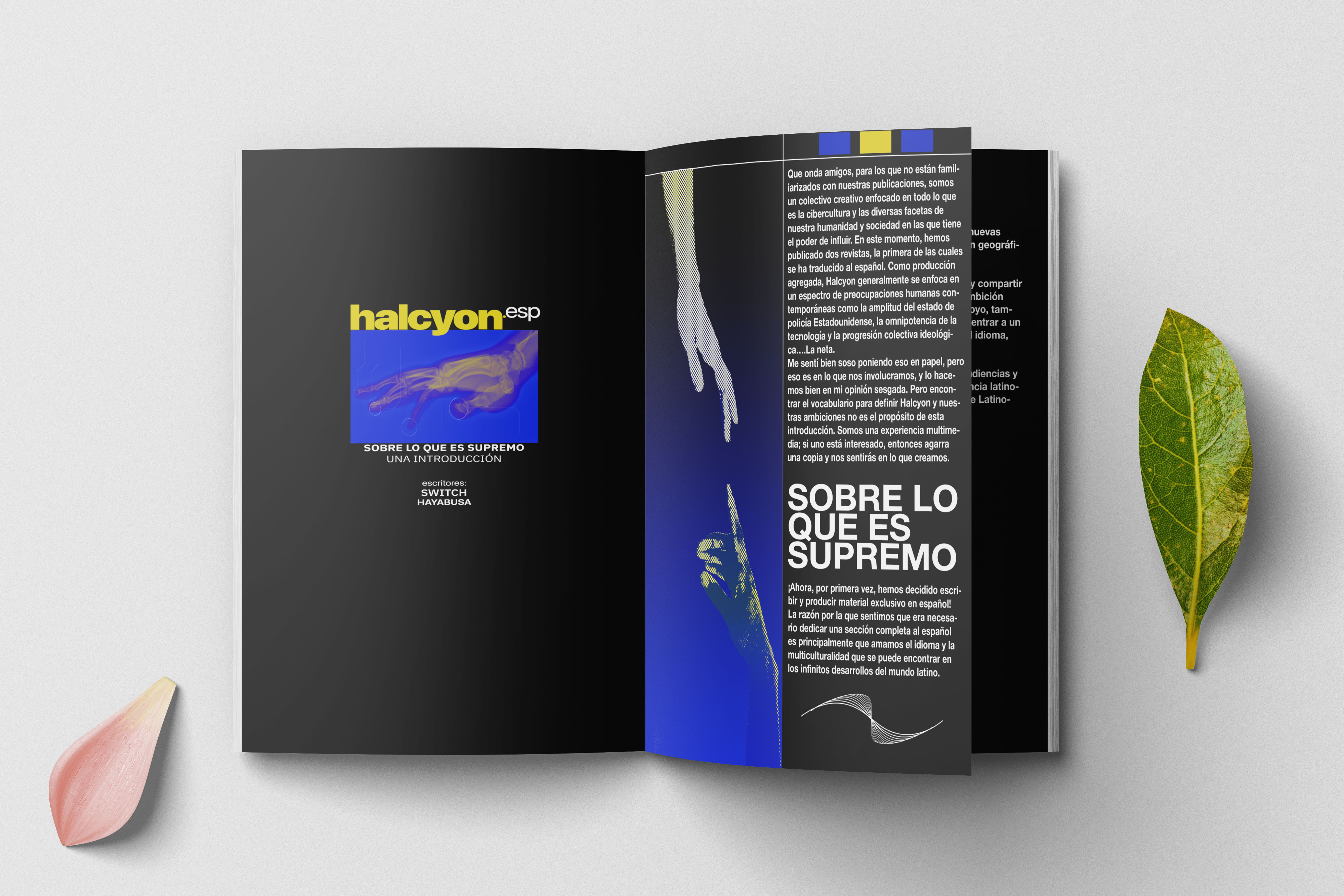
OFF LOG is a a mobile productivity app prototype developed between the months of February and May 2020 as part of a final project in the course ‘GAD 2079 – UX/Mobile App Design’ at Temple University’s Tyler School of Art in the Graphic Design department overseen by professor and designer Courtney Spencer.
You can view the finished prototype here.
An experiment in creating a wellness and productivity app that was completely modular in how the an app user was free to engage with it, my prototype was devised as a a time management and productivity app for people that don’t like time management and productivity apps (i.e. me).
Not all screen time is created equal - and in a world increasingly intermediated by our phones and devices (to the point where internet access can be a lifeline for people), it felt wrong to abide to the same old punitative measures of shaming people for scrolling or browsing their phone. Instead, Off Log was designed to reward thoughtful and mindful use of our devices rather than trying to fight them.
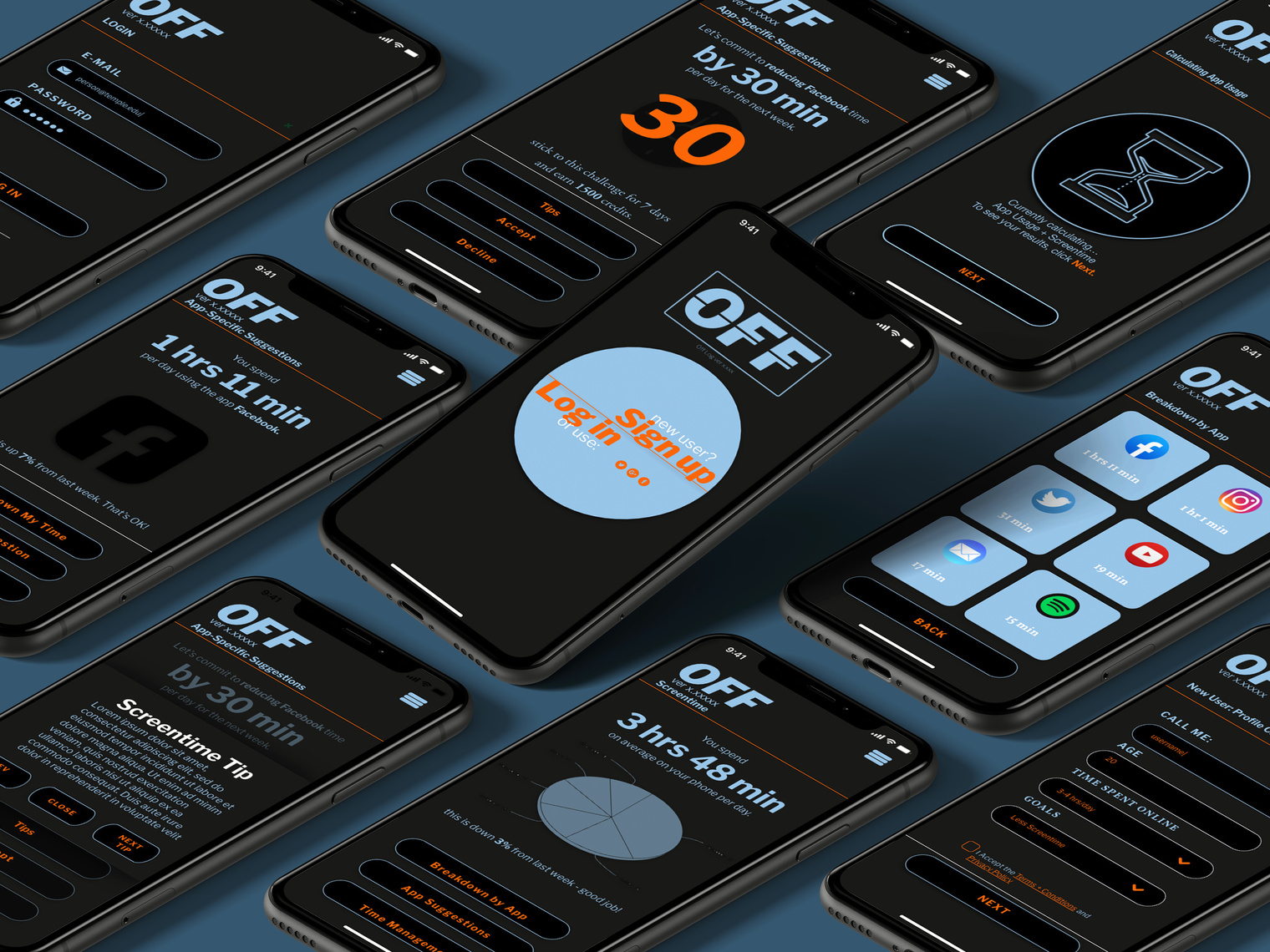
This is a case study recounting the background, research, decision-making process, design process and lessons learned from the creation of Off Log, a mobile productivity app prototype developed between the months of February and May 2020 as part of a final project in the course ‘GAD 2079 – UX/Mobile App Design’ at Temple University’s Tyler School of Art in the Graphic Design department. Prototyped in Adobe XD, it was my first experience going through the process of researching and designing the user experience and user interface for a product in a fully solo and self-directed manner. I essentially went from a complete novice to having a completed prototype in the span of one semester, and I ended up learning a lot as a result. This document attempts to sum up this experience and go into more detail about what I did and what I learned.

I wanted to do away with apps that beat you over the head with only your time spent on the device or on specific apps without considering the context in which someone might use that app. There’s thousands of articles and apps thatlecture users for aimlessly “doomscrolling” Instagram – but that doesn’t take into account the reality that for many people, Instagram is a significant part of their livelihood – for some, it’s an easy to use portfolio to showcase to clients, for others it’s a convenient route of communication to negotiate through direct messages, for others Instagram is literally their e-commerce storefront via Instagram Shopping.
And this was even before the Covid-19 pandemic hit most of the west and restricted us all to sitting in front of our devices for school and employment, once again changing what exactly the idea of screen-time means in our day-to-day lives.
Goals
Research
“Target market” aside, I had to actually confirm and research the idea that anyone was actually going to agree with the ideas about screen-time I was suggesting and would be willing to look into something like this.
Was anyone actually going to worry this much about their app lecturing them about time usage? Well, it’s no secret that people are becoming more sensitive to how much time they spend on looking at screens every day – researchers have already wrote much about our time in front of screens combined with the quality of life that we end up leading, particularly among the youth (Lacy et al, 2012).
According to a 2018 Nielsen study the average adult in the United States spent some 11 hours daily in front of a screen – watching TV, playing on consoles, browsing the web on their computers, or scrolling on their phone or tablets. The desire for “responsible tech usage” is growing in popularity thanks to users looking for a way to disconnect from an increasingly online world. Digital detoxes and programs like Google/Android’s Digital Wellbeing are growing in popularity –but for most people, their daily lives are so connected to the internet that they don’t have the means, time, or ability to make as drastic of a change as simply cutting out the internet.
At the other end of the spectrum, screen-time apps can give users an idea of how much time they’re actually spending in front of a screen, but sometimes these apps really only succeed in guilting their users rather than inspiring change (Davies 2018) or quite literally tracking them and barring them from accessing certain sites to force them into productivity, overstepping privacy lines in the process (Liptak 2019).
Just like people learn differently, people interact with the web differently, and it’s foolish to have a one-size-fits-all methodology to time management/screen-time apps. A screen-time survey from CodeComputerlove among 2,000+ people in the UK found that the average screen time per day among for users had been 3 hours and 23 minutes per day, or 50days out of the year.
While 83.75% of the surveyed said they were “definitely happy” or “OK” with the amount of time they spent looking at their phone, the 16-to-25 year old cohort was the most unhappy with the time spent on mobile devices, with 26% saying they were “not happy” with the amount of time spent online.
38% of people were reported to have a feeling of “connection” when using their mobile devices.
58% of people believed companies and social media businesses should be accountable for delivering “responsible technology” and helping reduce screen-time.
Ina survey of over 500 users on the news site Slate, parents spent an average of 3.29 hours a day on their mobile devices.
When it comes to screens of all kinds, they reported an average of 6 hours on a typical day, while their children averaged 2.27 hours a day on weekdays and nearly 5 hours per day on weekends.
A 2018 Deloitte survey showed Americans looked at their phone 52 times a day on average.
Tech protection company Asurion, meanwhile, reported that total was up to 80 times a day, despite Americans positively reacting to the “digital detox” trend.
I think it’s safe to say that for a lot of people, simply cutting off their connection to the web “cold-turkey” is unrealistic. So Off Log took a different approach – trying to modularly improve someone’s productivity, bit by bit.
![]()
![]()
![]()
The initial onboarding process and user flow for the prototype took as much inspiration from fitness tracker apps as it did from screen-time or "digital wellbeing" apps.Once the user has completed sign up, they’re prompted to initially complete their profile so that the app can generate some initial productivity strategies.
Like how fitness trackers prompt a user to add their weight/height/how much weight they want to lose, Off Log asks the user their age, how much time they spend on a phone per day, and what they are trying to get out of the app (be more productive/use their phone less/etc.). They can select which apps on their phone they are specifically trying to use less, or which apps they absolutely have to keep using because of work or family (these apps won’t be factored into the app’s productivity tracking). Specific apps can be marked as productive apps/”good” apps as well, which factor into the productivity suggestions the app generates for the user. Being able to pick and choose and prioritize apps for tracking is what I desired to include a "modular" feeling in the app and to give a user more autonomy over how they use it.
Once the user inputs this information the app generates some initial strategies based off of what the user has stated so far – suggestions for apps that the user could spend less time on, IRL alternatives, or more.
The app will recognize and congratulate users for sticking to productivity plans, using specific apps less, or spending less time on their phone.Through partnerships the app might be able to give users rewards that they can redeem either online (coupons for partner stores and apps) or in real life. (The things you're able to get away with proposing when you're just a student...)
Postmortem: What did you learn?
The biggest issue I ran into was the one that every singleperson ran into in the Spring of 2020 – Coronavirus. It made the process of putting this prototype together, group critiques, and testing with classmates incredibly difficult, and, probably to the surprise of no one, made us all glued to our devices in a truly new and groundbreaking way. How do you go about telling someone to get off their phone or iPad now? How do you go about telling your child to spend less time on their laptop when their school experience is now through a screen?I think it's only added to my impression that "digital wellbeing" in the upcoming years will look much different than simply counting time spent staring at our screens.
According to a 2018 Nielsen study the average adult in the United States spent some 11 hours daily in front of a screen – watching TV, playing on consoles, browsing the web on their computers, or scrolling on their phone or tablets. The desire for “responsible tech usage” is growing in popularity thanks to users looking for a way to disconnect from an increasingly online world. Digital detoxes and programs like Google/Android’s Digital Wellbeing are growing in popularity –but for most people, their daily lives are so connected to the internet that they don’t have the means, time, or ability to make as drastic of a change as simply cutting out the internet.
At the other end of the spectrum, screen-time apps can give users an idea of how much time they’re actually spending in front of a screen, but sometimes these apps really only succeed in guilting their users rather than inspiring change (Davies 2018) or quite literally tracking them and barring them from accessing certain sites to force them into productivity, overstepping privacy lines in the process (Liptak 2019).
Just like people learn differently, people interact with the web differently, and it’s foolish to have a one-size-fits-all methodology to time management/screen-time apps. A screen-time survey from CodeComputerlove among 2,000+ people in the UK found that the average screen time per day among for users had been 3 hours and 23 minutes per day, or 50days out of the year.
While 83.75% of the surveyed said they were “definitely happy” or “OK” with the amount of time they spent looking at their phone, the 16-to-25 year old cohort was the most unhappy with the time spent on mobile devices, with 26% saying they were “not happy” with the amount of time spent online.
38% of people were reported to have a feeling of “connection” when using their mobile devices.
58% of people believed companies and social media businesses should be accountable for delivering “responsible technology” and helping reduce screen-time.
Ina survey of over 500 users on the news site Slate, parents spent an average of 3.29 hours a day on their mobile devices.
When it comes to screens of all kinds, they reported an average of 6 hours on a typical day, while their children averaged 2.27 hours a day on weekdays and nearly 5 hours per day on weekends.
A 2018 Deloitte survey showed Americans looked at their phone 52 times a day on average.
Tech protection company Asurion, meanwhile, reported that total was up to 80 times a day, despite Americans positively reacting to the “digital detox” trend.
I think it’s safe to say that for a lot of people, simply cutting off their connection to the web “cold-turkey” is unrealistic. So Off Log took a different approach – trying to modularly improve someone’s productivity, bit by bit.
User Flow and Proposed Reward System

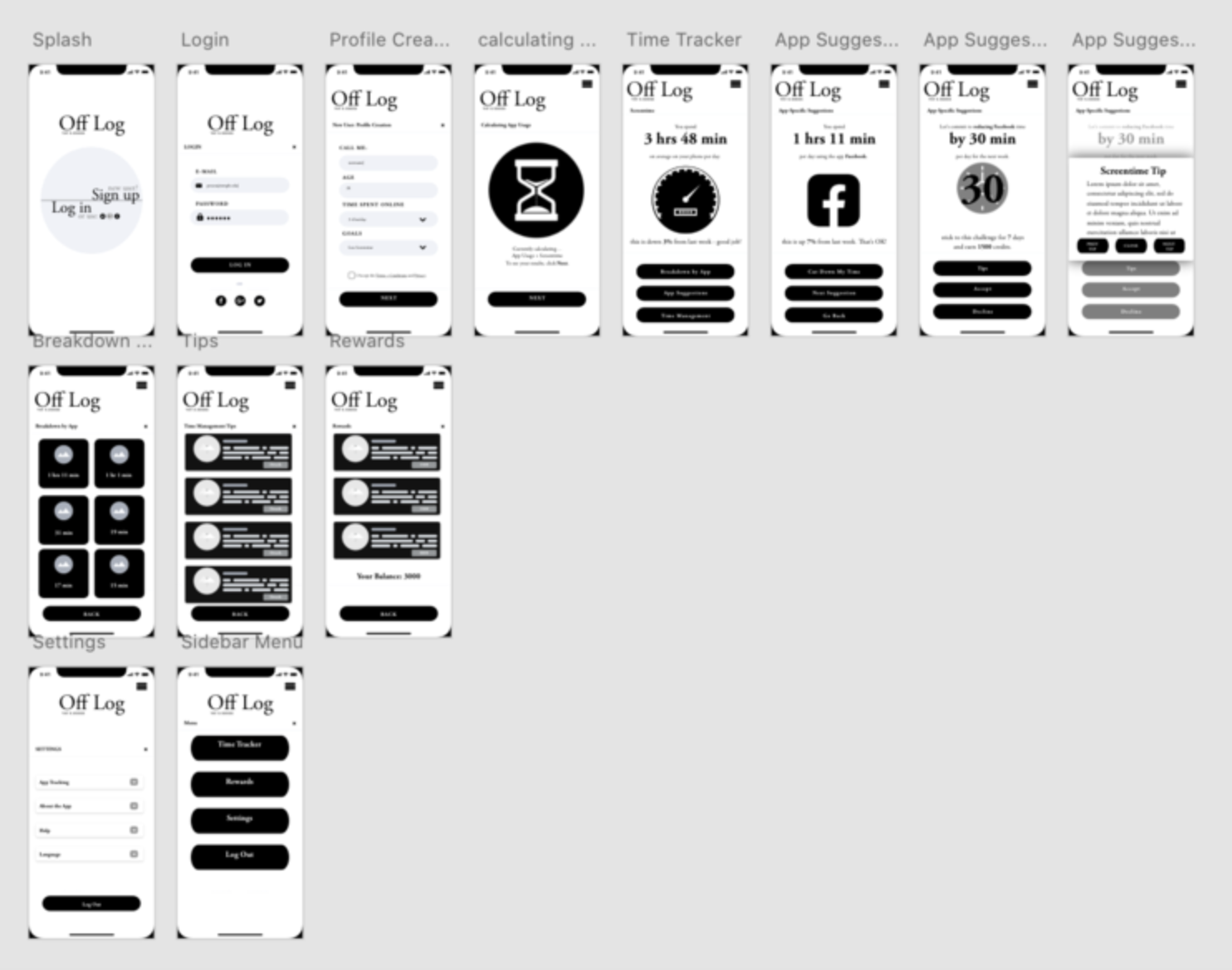

The initial onboarding process and user flow for the prototype took as much inspiration from fitness tracker apps as it did from screen-time or "digital wellbeing" apps.Once the user has completed sign up, they’re prompted to initially complete their profile so that the app can generate some initial productivity strategies.
Like how fitness trackers prompt a user to add their weight/height/how much weight they want to lose, Off Log asks the user their age, how much time they spend on a phone per day, and what they are trying to get out of the app (be more productive/use their phone less/etc.). They can select which apps on their phone they are specifically trying to use less, or which apps they absolutely have to keep using because of work or family (these apps won’t be factored into the app’s productivity tracking). Specific apps can be marked as productive apps/”good” apps as well, which factor into the productivity suggestions the app generates for the user. Being able to pick and choose and prioritize apps for tracking is what I desired to include a "modular" feeling in the app and to give a user more autonomy over how they use it.
Once the user inputs this information the app generates some initial strategies based off of what the user has stated so far – suggestions for apps that the user could spend less time on, IRL alternatives, or more.
The app will recognize and congratulate users for sticking to productivity plans, using specific apps less, or spending less time on their phone.Through partnerships the app might be able to give users rewards that they can redeem either online (coupons for partner stores and apps) or in real life. (The things you're able to get away with proposing when you're just a student...)
Postmortem: What did you learn?
The biggest issue I ran into was the one that every singleperson ran into in the Spring of 2020 – Coronavirus. It made the process of putting this prototype together, group critiques, and testing with classmates incredibly difficult, and, probably to the surprise of no one, made us all glued to our devices in a truly new and groundbreaking way. How do you go about telling someone to get off their phone or iPad now? How do you go about telling your child to spend less time on their laptop when their school experience is now through a screen?I think it's only added to my impression that "digital wellbeing" in the upcoming years will look much different than simply counting time spent staring at our screens.Addendum: Citations
More Than 500 Slate Readers Tell Us How They Handle Screen Time at Home. Retrieved from https://slate.com/technology/2017/12/results-of-slates-screen-time-survey-of-more-than-500-parents-about-rules-and-fights-about-tv-and-phones.html
Lacy, K., Allender, S., Kremer, P., De Silva-Sanigorski, A.,Millar, L., Moodie, M., . . . Swinburn, B. (2012). Screen time and physical activity behaviours are associated with health-related quality of life in Australian adolescents. Quality of Life Research, 21(6), 1085-1099.Retrieved February 23, 2020, from www.jstor.org/stable/23260007
Liptak, A. (2019, April 29). Apple explains why it's cracking down on third-party screen time and parental control apps. Retrieved from https://www.theverge.com/2019/4/27/18519888/apple-screen-time-app-tracking-parental-controls-report
Build it and they will embrace it. (2018). Retrieved fromhttps://www2.deloitte.com/us/en/pages/technology-media-and-telecommunications/articles/global-mobile-consumer-survey-us-edition.html#form
Screen-Time Statistics 2019: See the Latest Data on UK Smartphone Usage. (2019). Retrieved from https://www.codecomputerlove.com/blog/screen-time-stats
Time Flies: U.S. Adults Now Spend Nearly Half a Day Interactingwith Media. (2018, July 31). Retrieved fromhttps://www.nielsen.com/us/en/insights/article/2018/time-flies-us-adults-now-spend-nearly-half-a-day-interacting-with-media/
ASkySoBlack - Autumn In The Water (2022)
Photography - Teá Fish, Jordan Shteif, Mario Dante
Packaging, Album Layout - Triple Dog Studio
Photography - Teá Fish, Jordan Shteif, Mario Dante
Packaging, Album Layout - Triple Dog Studio
Album Artwork & art direction for ASkySoBlack EP, digital and physical editions, released 2022 on NMZ Records.
Additional artwork for physical merchandise + bandcamp storefront.
Additional artwork for physical merchandise + bandcamp storefront.
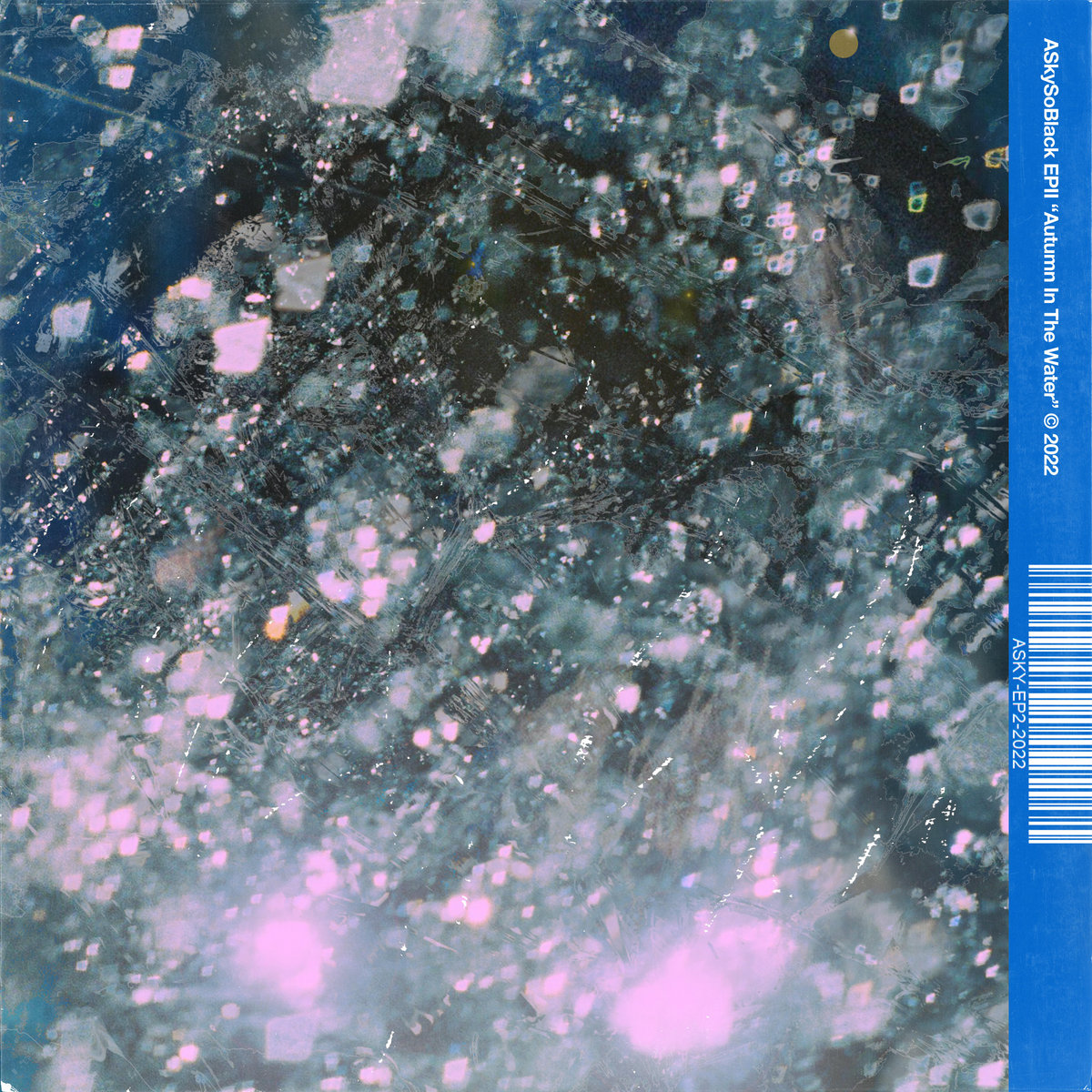


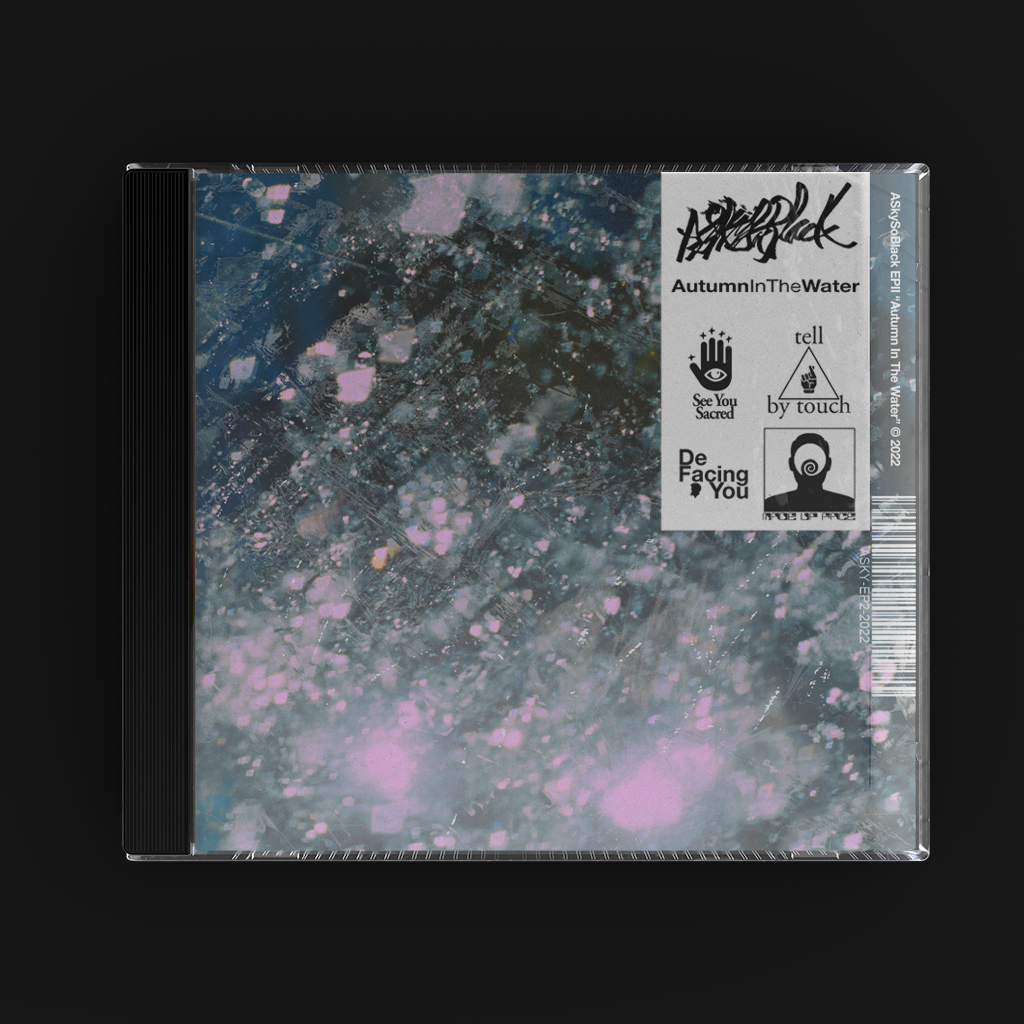
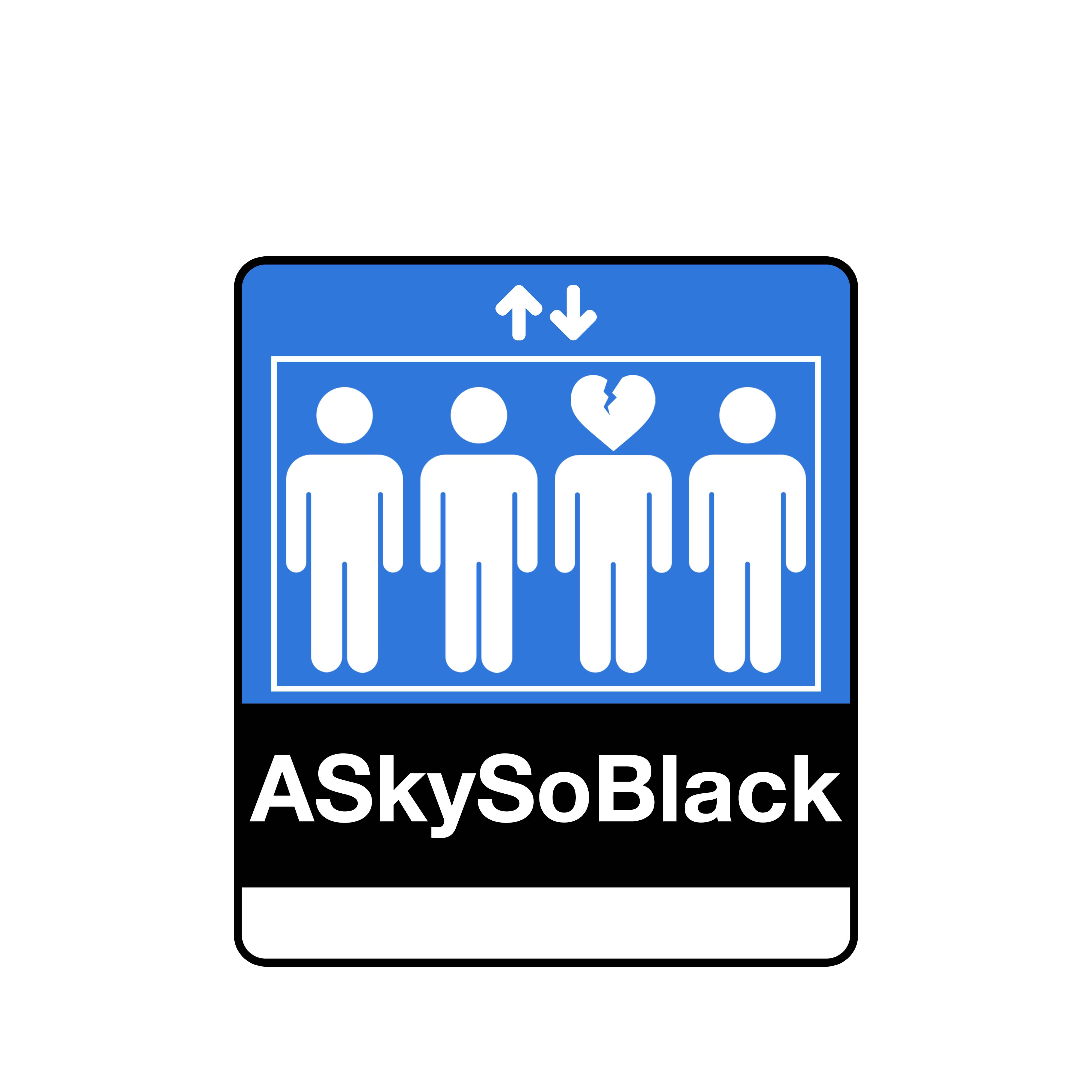


A glimpse into speculative sci-fi futures and a combination of my design and photographic practices,
PRISM was the photo and speculative design book detailing the final design and photographic work I completed as part of a light and optics workshop during my senior year at Temple University.
PRISM was the photo and speculative design book detailing the final design and photographic work I completed as part of a light and optics workshop during my senior year at Temple University.
It's available digitally via Gumroad's Pay What You Want model here.





